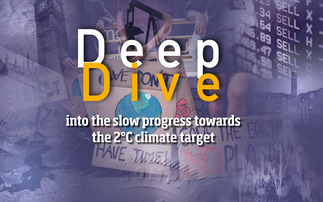
Key points
- The severity of the impact of plastic pollution continues to grow and the time horizon for consequent irreparable damage drawing ever closer.
- Governments have responded with initial measures to stem the use of ‘unnecessary’ plastic pollution and we expect stronger measures to come in the near future.
- The responsible use of plastics is an important consideration for evaluating the sustainability of a business and thus increasingly relevant to investors’ long-term decision-making.
A study carried out in 2015 showed that the cumulative mass of all virgin plastic ever created had reached 8.3 billion metric tons, with estimates that 6.3 billion tons of this plastic ended life as waste. Almost 80% of this waste remains in landfill or as pollution in the natural environment, with approximately 9% and 12% having been recycled and incinerated, respectively. Accounting for around 40% of all nonfiber plastics, plastic packaging represents a significant contributor to the problem.1 Consider that less than half of the one million plastic bottles sold every minute globally are being recycled2, with some polymers taking over 500 years to decompose, the issue of plastic waste is proving far from short-term.3
Regulatory responses to single-use plastics
In January 2018, coinciding with a rapid growth in media focus on ocean plastics, Chinese regulation banning imports of any paper or plastic waste came into effect.4 Given that China was the destination for approximately two-thirds of global plastic waste as recently as 2016, this legislation has had a major impact on governments, businesses and consumers.5 This galvanised an increase in debate on plastic waste, forcing other countries to deal with the issue. Countries across Europe set a precedent for plastic-limiting legislation, with bans on plastic microbeads and plastic-stemmed cotton buds announced in the UK and Scotland in January 2018,6,7 and a French ban on plastic cutlery from 2020.8, 9
Thus far, regulatory response has focused on single-use plastics and products deemed as unnecessary, such as microbeads, cotton buds, disposable cutlery, straws and coffee stirrers. However, other significant pollution sources remain unregulated.
Beyond packaging
According to National Geographic less than half of plastic ends life as packaging, leaving the rest to be used in other applications, including construction, transportation, electronics, consumer products, textiles and furniture.10 In fact, plastic waste from non-packaging applications is thought to be more likely to end up as ocean microplastic due to drains and sewers acting as ‘pollution vectors'. It has been estimated that 42 million tons of plastic pollution in existence in 2015 was as a result of use in textile fibres, making clothing a significant contributor to ocean waste.11 Just as microfibers are being transported into the ocean by washing clothing, dust and debris, most notably from car tyres, is arriving from urban environments via drains and rivers. It has been estimated that 63% of primary source ocean microplastics originate from synthetic textiles and car tyres.12
While a focus on single-use plastics and packaging is justified, tackling the wider problem of plastic pollution is necessary. In 2022, the United Nations Environment Assembly (UNEA) is expected to begin discussions on a landmark treaty to control plastic pollution globally, with negotiators scheduled to debate proposals for the legal binding rules on the wider use and disposal of plastic.13
We believe that responsible use is likely to have a much greater positive impact than the avoidance of all forms of plastic entirely; the challenge lies in assessing the balance between the benefits of using the material and the costs of designing it out entirely. Encouraging responsible use often requires assessment of an entire supply chain, taking into account factors such as resource efficiency, product longevity and the use of circular economy initiatives.
Indicators of responsible use
Leading companies are likely to maximise opportunity by collaborating across industries, working within the public and private sectors. Indicators to look for in leading companies can be broken down into three broad areas:
- Transparency and accountability
The level of voluntary disclosure by companies can be used as an indicator of potential resilience to consumer groups shifting their appetite away from plastic-heavy purchases. Proactive disclosure and target setting may also lower the risk of being subject to top down, prohibitive legislation. In best practice cases these targets are highly visible and embedded in company values. Integrated reporting with clear relevance to the impact, product or operations of the company should be taken with greater weight than the isolated publication of statistics.
- Materials use - recycled content and the circular economy
Targeting an increase in the percentage of recycled content used by companies may be a greater driver for change than encouraging the production of recyclable items, potentially impacting practices further along supply chains by growing demand for recycled material. Although not yet universally possible, companies carrying out early research in materials' use are likely to benefit. Types of plastic used will begin to narrow as recycling infrastructure develops, creating opportunities for leaders in the area. However, until the supply of recycled polymers has both increased and stabilised, overambitious companies may be likely to miss targets on the use of recycled content due to the availability of recycled material.
Policies that either integrate circular economy thinking into operations or encourage the designing out of the material altogether, indicate long-term thinking in this area. The early integration of circular economy models, such as take-back initiatives, reverse logistics and modular design has the potential for significant benefit through increased efficiency, industry recognition and first-mover advantage.
- Collaboration
Opportunities exist owing to future increased demand for recycling facilities, new logistics solutions for circular economy or deposit-return initiatives, and new materials that will be required to replace single use plastics. As many of these developments span several industries, companies creating or joining collaborative initiatives are likely to excel, particularly those working vertically along value chains and investing in recyclable technology and infrastructure.
Those working with policymakers to influence consumer behaviour are likely to benefit from positive public image and potential government support, with programmes around improving recovery rates having the co-benefit of increasing the availability of recycled material.
A balancing act
Identifying the primary sources of environmental risks and opportunities is a complex and ongoing process. The full sustainability impact of plastic usage is a result of many interconnected - and often unclear - factors. For instance, food packaging has been targeted by consumer groups and regulators despite evidence that the packaging helps to deliver food safely, increase shelf life and reduce food waste. Similarly, the delivery of medicines, clean water, and sterilised products relies on plastic, as do numerous resource efficiency improvements across transport and logistics industries.
The relevance of plastic use varies greatly with company and industry, meaning that there is not yet one single solution or identifier for positive impact, investment risk or investment opportunity. We seek companies which are intentional, transparent and consistent in their approach - with regards to both products/services and operations - as we believe this provides the best assurance of its long-term trajectory of a business.
Visit our website to find out more about the Janus Henderson Global Sustainable Equity strategy and discover the latest expert insights from the team.
References
1 R. Geyer, J. R. Jambeck and K. L. Law, "Production, use, and fate of all plastics ever made" Science Advances, vol. 3, no. 7, 1 7 2017.
2 Plastic Soup Foundation, "The Worlds Population Consumes 1 Million Plastic Bottles Every Minute", accessed 24 February 2022
3 World Wide Fund for Nature (WWF) Australia, "The lifecycle of plastics", as at 2 July 2021, accessed 24 February 2022
4 UN Environment, "China's trash ban lifts lid on global recycling woes but also offers opportunity", as at 6 July 2018, accessed 24 February 2022
5 Bloomberg, "China Upended the Politics of Plastic and the World Is Still Reeling", as at 21 January 2020, accessed 24 February 2022
6 Kevin Keane, BBC News, "Scotland ban announced for plastic cotton buds", as at 11 January 2018, accessed 24 February 2022
7 UK Government press release, "World leading microbeads ban comes into force", as at 19 June 2018, accessed 24 February 2022
8 Climate Action, "France ban plastic plates and cutlery", as at 20 September 2016, accessed 24 February 2022
9 United Nations environment programme, "World leaders set sights on plastic pollution", as at 16 February 2022, accessed 24 February 2022
10 National Geographic, "Fast facts about plastic pollution", as at 20 December 2018, accessed 24 February 2022
11 European Environment Agency, "Plastic in textiles: towards a circular economy for synthetic textiles in Europe", as at 17 September 2021, accessed 24 February 2022
12 J. Boucher and D. Friot, ICUN, "Primary microplastics in the oceans: A global evaluation of sources," 2017.
13 United Nations Environment Programme, February 2022
Important information
This document is intended solely for the use of professionals, defined as Eligible Counterparties or Professional Clients, and is not for general public distribution.
Past performance does not predict future returns. Marketing communication. The value of an investment and the income from it can fall as well as rise and investors may not get back the amount originally invested. There is no assurance the stated objective(s) will be met. Nothing in this document is intended to or should be construed as advice. This document is not a recommendation to sell, purchase or hold any investment.
There is no assurance that the investment process will consistently lead to successful investing. Any risk management process discussed includes an effort to monitor and manage risk which should not be confused with and does not imply low risk or the ability to control certain risk factors.
Various account minimums or other eligibility qualifications apply depending on the investment strategy, vehicle or investor jurisdiction. We may record telephone calls for our mutual protection, to improve customer service and for regulatory record keeping purposes.
Issued in Europe by Janus Henderson Investors. Janus Henderson Investors is the name under which investment products and services are provided by Janus Capital International Limited (reg no. 3594615), Henderson Global Investors Limited (reg. no. 906355), Henderson Investment Funds Limited (reg. no. 2678531), Henderson Equity Partners Limited (reg. no.2606646), (each registered in England and Wales at 201 Bishopsgate, London EC2M 3AE and regulated by the Financial Conduct Authority) and Henderson Management S.A. (reg no. B22848 at 2 Rue de Bitbourg, L-1273, Luxembourg and regulated by the Commission de Surveillance du Secteur Financier). Investment management services may be provided together with participating affiliates in other regions.
Janus Henderson, Janus, Henderson, Intech, Knowledge Shared, Knowledge. Shared and Knowledge Labs are trademarks of Janus Henderson Group plc or one of its subsidiaries. © Janus Henderson Group plc.














